Going into Philadelphia, we took the SEPTA Regional Rail Media-Wawa Line train from Wawa to 49th Street, then Trolley Route 13 to 22nd Street.
 |
| First stop was the Mütter Museum (1909) |
 |
| In respect to human remains, no photography is allowed in the museum, only in the lobby and garden; Tamiko and Kent with an Iron Lung (BAS) |
 |
| The Grand Staircase to the Historical Medical Library and Collections for research |
 |
| The Benjamin Rush Medicinal Plant Garden (1937) exhibits plants that have historical and contemporary medicinal value |
 |
| Allium sativum/Garlic |
 |
| Sarracenia spp/Pitcher plants |
 |
| White Garden with Phlox paniculata 'David' |
 |
| White Garden with Anemone hupehensis 'Honorine Jobert' |
 |
| 23rd Street Armory (1901, by Gillette Woodman) is home to the First Troop Philadelphia City Cavalry |
 |
| The former Church of the New Jerusalem (1881, by Theophilus Parsons Chandler) of the Swedenborgian church, is now offices |
 |
| First Unitarian Church of Philadelphia (est 1796, this 3rd bldg 1883-1886, by Frank Furness, in modest English country church Gothic style) |
 |
| Th hammer-beam ceiling is an open timber roof truss; here it is painted rust red stenciled with gold-leaf daffodils |
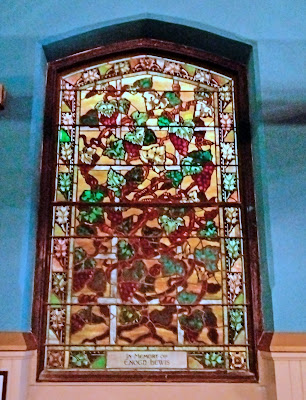 |
| One of a pair of stained glass windows designed by Louis Tiffany & Company for the Lewis Memorial Windows (1908) |
 |
| The second Lewis Memorial Window |
 |
| Tiffany also designed the rose window titled Blessed are the Pure in Heart (1889) |
 |
| The opposite rose windowis titled Isaiah (1891, by John La Farge) |
 |
| Concert-grade Casavant pipe organ (1966) with 3 manuals and 50 ranks |
 |
| Lutheran Church of the Holy Communion (1880, by Isaac Pursell in Richardsonian Romanesque style for St Paul's Reformed Episcopal Church, sold in 1903) |
 |
| First Presbyterian Church in Philadelphia (est 1692, 1872 by Henry Augustus Sims in French Gothic style, tower 1901 by Frank Furness in English Gothic style) |
 |
| Marie Louise Weightman Faries Memorial Window (c 1898, attributed to Fannie Sweeney) |
 |
| Emily B McFadden Window (1914, signed by Tiffany Studios) |
 |
| The Prophet Windows (c 1906, also by Tiffany) represent Abraham, Joseph, Samuel, Moses, Elijah, Isaiah, and Daniel |
 |
| The Rev Dr J Ernest Somerville Window (1988, by Willet Studios) in memory of a minister who served for 30 years, and the Dove Window |
 |
| Church of the Holy Trinity (1859, by John Notman in Norman or Neo-Romanesque style) was closed for a rehearsal |
 |
| Lion Crushing a Serpent (1832, by Antoine-Louis Barye, cast in 1890) is an allegory of the 1830 French revolution |
 |
| Neptune Fountain and Children's Pool |
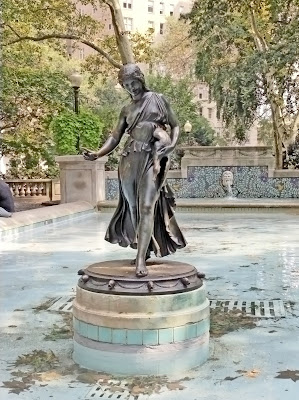 |
| Duck Girl (1911, by Paul Manship) was first exhibited in 1914 at the Pennsylvania Academy of the Fine Arts, went in storage in 1956, then relocated here in 1960 |
 |
| Billy (1914, by Albert Laessle) |
 |
| The back of the Neptune Fountain |
 |
| Giant Frog (1941, by Cornelia Van Auken Chapin) |
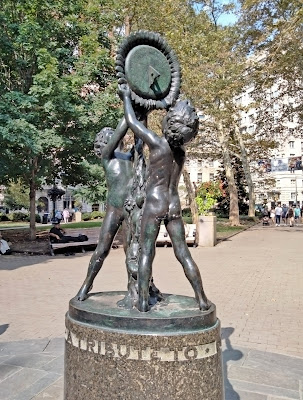 |
| Evelyn Taylor Price Memorial Sundial (1947, by Beatrice Fenton) |
 |
| Flower-filled planters at the NE corner of Rittenhouse Square |
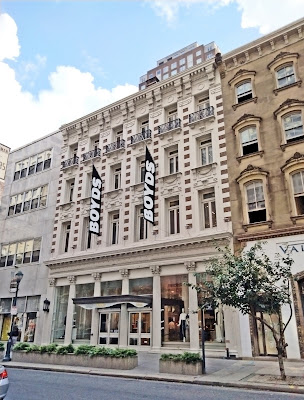 |
| Boyds luxury department store (est 1938, 1990 moved into Oliver H Bair building, 1907 by John T Windrim in Renaissance Revival style) |
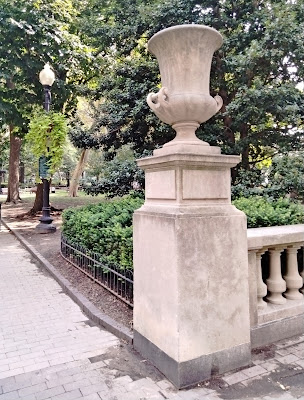
No comments:
Post a Comment